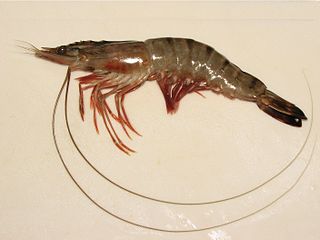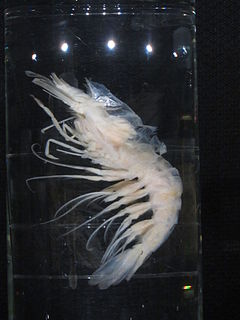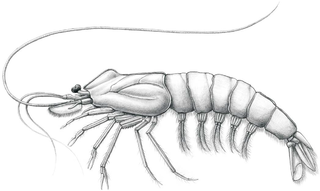
Penaeidae is a family of marine crustaceans in the suborder Dendrobranchiata, which are often referred to as penaeid shrimp or penaeid prawns. The Penaeidae contain many species of economic importance, such as the tiger prawn, whiteleg shrimp, Atlantic white shrimp, and Indian prawn. Many prawns are the subject of commercial fishery, and farming, both in marine settings, and in freshwater farms. Lateral line–like sense organs on the antennae have been reported in some species of Penaeidae. At 210 metres per second (760 km/h), the myelinated giant interneurons of pelagic penaeid shrimp have the world record for impulse conduction speed in any animal.
TriCore is a 32-bit microcontroller architecture from Infineon. It unites the elements of a RISC processor core, a microcontroller and a DSP in one chip package.

Sergestidae is a family of prawns which have lived since at least the Middle Jurassic (Bajocian/Bathonian). It contains the following genera:

Joseph VI Audo (1790–1878) was the Patriarch of the Chaldean Catholic Church from 1847 to 1878.

Gaëtan Charbonnier is a French professional footballer who plays as a striker for Ligue 1 club Brest.

Benthesicymus is a genus of prawns, containing the following species:

Cancrinos is a genus of fossil crustacean closely allied with the slipper lobsters. One species is known, C. claviger from the Jurassic of southern Germany.
Tricarina is a genus of crustaceans of uncertain phylogenetic placement, known from a single incomplete fossil specimen from the Cretaceous of western Iran. It has a flattened body with three longitudinal ridges, which give it its name.

Palaeobenthesicymus is an extinct genus of prawns which existed in what is now Lebanon in the Late Santonian. It was described by Denis Audo and Sylvain Charbonnier in 2013, as a new genus for the species Penaeus libanensis, first described by P. Brocchi in 1875.
This list of fossil arthropods described in 2016 is a list of new taxa of trilobites, fossil insects, crustaceans, arachnids and other fossil arthropods of every kind that have been described during the year 2016, as well as other significant discoveries and events related to arthropod paleontology that occurred in the year 2016.
This list of fossil arthropods described in 2017 is a list of new taxa of trilobites, fossil insects, crustaceans, arachnids and other fossil arthropods of every kind that are scheduled to be described during the year 2017, as well as other significant discoveries and events related to arthropod paleontology that are scheduled to occur in the year 2017.
This list of fossil arthropods described in 2018 is a list of new taxa of trilobites, fossil insects, crustaceans, arachnids and other fossil arthropods of every kind that were described during the year 2018, as well as other significant discoveries and events related to arthropod paleontology that are scheduled to occur in the year 2018.
This list of fossil arthropods described in 2019 is a list of new taxa of trilobites, fossil insects, crustaceans, arachnids and other fossil arthropods of every kind that are scheduled to be described during the year 2019, as well as other significant discoveries and events related to arthropod paleontology that are scheduled to occur in the year 2019.
Paracancrinos is a prehistoric genus of crustacean that lived during the Upper Cretaceous in what is now Lebanon. It contains a single species, P. libanensis, which was originally described as a species of Cancrinos in 2006, but was moved to its own genus in 2016.
Charbelicaris is a prehistoric genus of crustacean that lived during the Upper Cretaceous in what is now Lebanon.
Pachyacanthus is an extinct genus of toothed whale that lived about 15.97 to 2.589 million years ago. It contains the single species Pachyacanthus suessi. The genus is known from European deposits in Hungary, Kazakhstan, Austria and Italy. The type specimen consisted of a few fragments of a rostrum and two fragmentary tympanic bullae. Skeletons from the Sarmatian of Austria did not include skulls.

The Calcare di Sogno is a geological formation in Italy, dated to roughly between 183-181 million years ago and covering the Toarcian stages of the Jurassic Period in the Mesozoic Era. Thallatosuchian remains are known from the formation.
2020 in arthropod palentology is a list of new arthropod fossil taxa, including arachnids, crustaceans, insects, trilobites, and other arthropods that were announced or described, as well as other significant arthropod paleontological discoveries and events which occurred in 2020.

The Moltrasio Formation also known as Lombardische Kieselkalk Formation is a geological formation in Italy. This Formation mostly developed on the Lower or Middle Sinemurian stage of the Lower Jurassic, where on the Lombardian basin tectonic activity modified the current marine and terrestrial habitats. Here it was developed a series of marine-related depositional settings, represented by an outcrop of 550–600 m of grey Calcarenites and Calcilutites with chert lenses and marly interbeds, that recovers the Sedrina, Moltrasio and Domaro Formations. This was mostly due to the post-Triassic crisis, that was linked locally to tectonics. The Moltrasio Formation is considered a continuation of the Sedrina Limestone and the Hettangian Albenza Formation, and was probably a shallow water succession, developed on the pasive margin of the westernmost Southern Alps. It is known due to the exquisite preservation observed on the Outcrop on Osteno, where several kinds of marine biota have been recovered.
2021 in arthropod palentology is a list of new arthropod fossil taxa, including arachnids, crustaceans, insects, trilobites, and other arthropods that were announced or described, as well as other significant arthropod paleontological discoveries and events which occurred in 2021.








